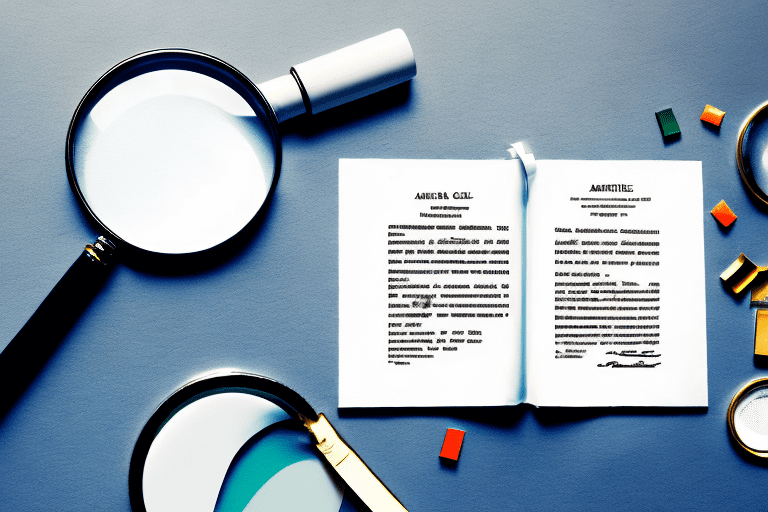Counterfeiting is a pervasive issue that affects industries worldwide. From luxury goods to pharmaceuticals, counterfeit products not only damage the reputation of legitimate brands but also pose serious health and safety risks to consumers. In order to combat this problem, it is crucial to understand the intricacies of counterfeiting, the role of patents, the Manual of Patent Examining Procedure (MPEP), and the Patent Bar. This article delves into these topics, providing insights into the fight against counterfeiting and the key players involved.
Understanding Counterfeiting and its Impact
Counterfeiting, in its simplest form, refers to the illegal production and distribution of goods that mimic genuine products. However, the impacts of counterfeiting go far beyond mere financial loss for companies. Counterfeit goods often lack the quality control measures typical of legitimate products, leading to potential harm to unsuspecting consumers.
Counterfeiting is not a new phenomenon. It has been around for centuries, with counterfeit coins and banknotes being some of the earliest examples. However, in today’s digital age, counterfeiting has become even more prevalent and sophisticated. With advances in technology, counterfeiters can now replicate the appearance and packaging of genuine products with alarming accuracy.
The Basics of Counterfeiting
The process of counterfeiting involves replicating the appearance and packaging of a genuine product to deceive consumers. Counterfeiters often attempt to mimic popular brands and create fake versions that are sold at lower prices. These products are manufactured using substandard materials and are not subject to the rigorous quality control measures employed by original manufacturers.
Counterfeit goods are commonly sold through illegal channels, including unauthorized websites, street markets, and even brick-and-mortar stores. The widespread availability of counterfeit products not only compromises the market share and revenue of legitimate companies but also damages their brand image. Consumers who unknowingly purchase counterfeit goods may be left with a negative perception of the genuine brand, impacting its reputation in the long run.
Moreover, the production and distribution of counterfeit goods often involve organized crime networks. These criminal enterprises engage in various illegal activities, including money laundering, tax evasion, and even human trafficking. The profits generated from counterfeiting are used to fund other illicit operations, posing a significant challenge to law enforcement agencies worldwide.
The Global Impact of Counterfeiting
Counterfeiting is a global problem that affects both developed and developing countries. According to the International Chamber of Commerce, counterfeiting and piracy cost the global economy up to $820 billion annually. This staggering figure not only demonstrates the scale of the problem but also highlights the need for effective measures against counterfeiting.
Counterfeit goods pose significant risks to consumer health and safety, as they often do not adhere to proper manufacturing standards. Counterfeit pharmaceuticals, for instance, may not contain the necessary active ingredients or may contain harmful substances, putting patients at risk. In some cases, counterfeit electrical products can be a fire hazard, endangering the lives of consumers.
Furthermore, the impact of counterfeiting extends beyond economic losses. It affects innovation and intellectual property rights, discouraging companies from investing in research and development. When counterfeiters profit from stolen designs and ideas, it undermines the incentive for genuine creators to continue innovating.
The fight against counterfeiting requires a multi-faceted approach, involving collaboration between governments, law enforcement agencies, and businesses. Efforts to raise awareness among consumers about the dangers of counterfeit goods are also crucial in combating this global problem.
In conclusion, counterfeiting is not a victimless crime. It undermines legitimate businesses, poses risks to consumer health and safety, and contributes to a range of illegal activities. Understanding the basics of counterfeiting and its global impact is essential in developing effective strategies to combat this pervasive problem.
An Introduction to Patents
In the fight against counterfeiting, patents play a crucial role. A patent is a legally recognized exclusive right granted by a government to an inventor or assignee, providing protection for a new invention or a unique solution to a problem. Patents act as a deterrent to counterfeiters by giving inventors the right to exclude others from making, using, or selling their invention without permission.
What is a Patent?
A patent grants inventors the exclusive rights to their invention for a limited period, typically twenty years. By protecting intellectual property, patents incentivize innovation and provide a framework for legal recourse in cases of infringement.
But what exactly is considered patentable? Patents can be granted for various types of inventions, including new products, processes, or improvements to existing products or processes. The patent application process involves disclosing the details of the invention and demonstrating its novelty, usefulness, and non-obviousness.
When an inventor applies for a patent, they must provide a detailed description of their invention, including any drawings or diagrams that help illustrate its functionality. The patent application is then examined by a patent examiner to ensure that the invention meets the criteria for patentability. This examination process can be lengthy and complex, requiring the inventor to provide evidence and arguments to support their claim of novelty and non-obviousness.
The Importance of Patents in Anti-counterfeiting
Patents are an essential tool in the fight against counterfeiting. By providing inventors with exclusive rights to their inventions, patents enable legitimate manufacturers to prevent unauthorized production and sale of counterfeit products. When a patent is infringed upon, the patent holder can take legal action to protect their intellectual property and seek damages.
However, the impact of patents goes beyond legal protection. The existence of a patent can discourage potential counterfeiters from replicating innovative products, as they risk facing legal consequences and damaging their own reputation. This deterrent effect can help safeguard the market for genuine products and promote fair competition.
Moreover, patents contribute to the overall advancement of technology and society. By granting inventors exclusive rights for a limited period, patents create an incentive for inventors to disclose their inventions to the public. This disclosure of knowledge allows other inventors and researchers to build upon existing inventions, leading to further innovation and progress.
Furthermore, patents can also serve as a valuable asset for inventors and businesses. A granted patent can be licensed or sold, providing the patent holder with additional revenue streams. This can be particularly beneficial for small inventors or startups who may not have the resources to bring their inventions to market on their own.
In conclusion, patents play a vital role in the fight against counterfeiting and the promotion of innovation. By granting exclusive rights to inventors, patents provide a legal framework for protecting intellectual property and incentivize the development of new and groundbreaking inventions. The impact of patents extends beyond legal protection, acting as a deterrent to counterfeiters and fostering a culture of disclosure and collaboration. As technology continues to advance, the importance of patents in our society will only continue to grow.
A Deep Dive into the Manual of Patent Examining Procedure (MPEP)
The Manual of Patent Examining Procedure (MPEP) is a comprehensive guide published by the United States Patent and Trademark Office (USPTO). It provides examiners, applicants, attorneys, and other stakeholders with detailed instructions on the patent examination process and the requirements for patentability.
The Role of the MPEP in Patent Examination
The MPEP serves as a reference manual for patent examiners, helping them navigate the complex patent examination process. It provides guidance on various topics, including patentability criteria, patent prosecution procedures, and legal interpretations of patent laws.
Examiners use the MPEP as a tool to ensure consistency and accuracy in the evaluation of patent applications. By following the guidelines outlined in the MPEP, examiners can make informed decisions regarding the patentability of inventions and help maintain the integrity of the patent system.
How the MPEP Helps in Anti-counterfeiting
The MPEP plays a crucial role in anti-counterfeiting efforts by providing examiners with a standardized framework for assessing patent applications. This ensures that inventions deserving of patent protection are granted, while counterfeit or non-patentable inventions are rejected.
Additionally, the MPEP serves as a valuable resource for inventors and their legal representatives, helping them navigate the complex process of applying for and obtaining a patent. By understanding the guidelines set forth in the MPEP, inventors can strengthen their patent applications and increase their chances of obtaining effective protection against counterfeiters.
The Patent Bar: A Crucial Player in Anti-counterfeiting
The Patent Bar, also known as the United States Patent and Trademark Office (USPTO) registration examination, is a rigorous test that individuals must pass to become registered practitioners before the USPTO. Registered Patent Attorneys and Agents play a vital role in the patent prosecution process and are essential partners in the fight against counterfeiting.
The Function of the Patent Bar
The Patent Bar evaluates the competency of individuals seeking to practice before the USPTO. It ensures that only qualified professionals with a thorough understanding of patent law and procedure are allowed to represent inventors and applicants.
Registered Patent Attorneys and Agents have the expertise to draft and prosecute patent applications, engage in patent litigation, and provide legal counsel to inventors and applicants. They are well-versed in the intricacies of the patent system and play a crucial role in protecting the intellectual property rights of inventors.
The Patent Bar’s Role in Combating Counterfeits
Registered Patent Attorneys and Agents are key stakeholders in the fight against counterfeiting. They help inventors secure patent protection for their innovations, ensuring exclusive rights that act as a strong deterrent against counterfeiters.
Patent Bar practitioners play a crucial role in identifying and addressing instances of patent infringement. They have the expertise to analyze complex intellectual property disputes and represent inventors in legal proceedings. By actively defending patents from counterfeiters, they contribute to safeguarding innovation and upholding the principles of market fairness.
Case Studies: Patents, MPEP, and the Patent Bar in Action
Examining successful anti-counterfeiting cases sheds light on the effectiveness of patents, the MPEP, and the role of the Patent Bar. Learning from past cases serves as a valuable tool in formulating strategies to combat counterfeiting effectively.
Successful Anti-counterfeiting Cases
In one notable case, a luxury fashion brand successfully utilized patents to combat counterfeiting. By filing multiple patents for unique design elements and innovative production techniques, the company established a strong intellectual property portfolio that acted as a deterrent to counterfeiters.
In another instance, a pharmaceutical company relied on the MPEP to strengthen their patent applications for a groundbreaking medical device. The company’s thorough understanding of the MPEP guidelines helped them secure patent protection, preventing unauthorized production of counterfeit devices.
Lessons Learned from Past Cases
From successful anti-counterfeiting cases, several lessons emerge. First and foremost, patents are invaluable in the fight against counterfeiting as they provide legal protection and deter counterfeiters from reproducing innovative products. Patent holders should proactively leverage their exclusive rights to defend against counterfeiters and seek legal action when necessary.
Additionally, understanding and adhering to the guidelines outlined in the MPEP is key to obtaining effective patent protection. Inventors and their legal representatives should carefully navigate the patent application process, ensuring compliance with the MPEP’s requirements to maximize their chances of success.
In conclusion, anti-counterfeiting efforts require a multi-faceted approach that incorporates patents, the MPEP, and the expertise of the Patent Bar. By understanding the basics of counterfeiting, the role of patents in the fight against counterfeit goods, the significance of the MPEP, and the crucial function of the Patent Bar, we can collectively work towards mitigating the impact of counterfeiting and safeguarding innovation.






